Toilets can work well for decades, but you notice a huge difference when something goes wrong. One of the most frequent bathroom issues is when the toilet water rises then slowly drains.
It doesn’t overflow, but it is a warning sign that shouldn’t be ignored.
Here are 10 reasons why toilet water rises and slowly drains:
- Partial Clog: A minor obstruction can allow water to pass slowly, causing the water to rise initially.
- Vent Blockage: Blocked vent pipes can hinder proper airflow, affecting the flushing efficiency.
- Flapper Issues: A malfunctioning flapper can prevent the toilet from flushing powerfully.
- Sediment Build-up: Over time, mineral deposits can accumulate in the trap, slowing down the water flow.
- Worn Out Parts: Aging or deteriorated parts can affect flushing force.
- Low Flow Design: Some older low-flow toilets may not have a strong flush, causing slow drainage.
- Blocked Sewer Line: A larger blockage in the main sewer line can affect drainage in the toilet.
- Foreign Objects: Items like toys, sanitary products, or excessive toilet paper can cause obstructions.
- Collapsed Drain Line: A sagging or collapsed section of the line can hinder smooth water flow.
- Tree Roots: Roots from nearby trees can infiltrate and block the sewer lines.
Read on for a further explanation on the main causes, how to identify what your issue is, and how to fix a slow draining toilet.
Table of Contents
What Causes a Toilet to Fill up with Water and Drain Slowly?
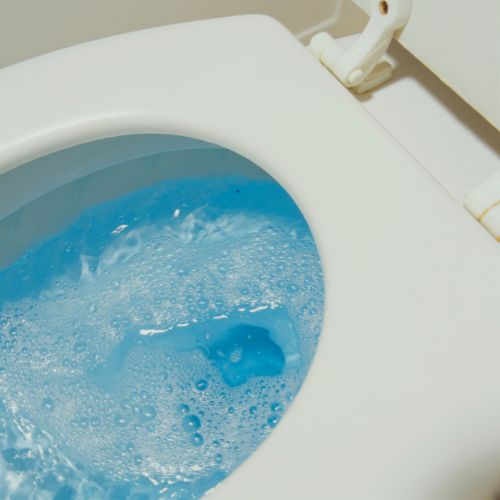
If your toilet bowl fills up with water but is slow draining, these are the most common reasons:
Partial Blockage
If you have a partial blockage, you’ll notice the water rises high, almost to the brim and then slowly goes down. There are many reasons that can cause a clogged drain, including:
- Excessive Paper: Using too much toilet paper or non-dissolvable wipes clogging the drain.
- Foreign Objects: Toys, sanitary products, cat litter, and other non-degradable materials can create obstructions.
- Hard Water Deposits: Buildup can accumulate in the trap or jet holes, affecting water flow.
- Waste: Large amounts of human waste or a combination of waste and toilet paper can sometimes form a blockage.
- Collapsed Drain Line: While not within the toilet itself, a collapse in the main line can cause toilets to drain slowly or not at all.
Blockages and clogs are the most common reason for a toilet draining slowly.
Venting Problem
In plumbing, vents, often termed “vent stacks” or “stink pipes”, allow sewer gases to be vented outside of the house. They admit outside air into the drainage system to keep the atmospheric pressure inside and outside balanced. A blockage in these vents can disrupt this balance, causing drainage problems.
Common causes of venting problems include:
- Bird Nests: Birds often find vent pipes a cozy place to build nests.
- Dead Animals: Small animals like birds or rodents can sometimes fall into open vent pipes and get stuck.
- Debris: Leaves, twigs, or other debris can fall into the vent pipe, especially if there’s no cap.
- Snow and Ice: In colder climates, vents can become blocked by snow or ice.
- Dirt and Dust: Over time, these can accumulate and cause a blockage.
If you have a blocked vent you may hear a gurgling sound or bubbles when the toilet flushes. It may fill with water, then slowly drains. The sewer gases may cause odors and bad smells inside the house as they come back into the house. As the air pressure isn’t balanced, the slow-draining toilet may get more frequent over time.
Malfunctioning Flapper
The flapper is a rubber or plastic valve that covers the opening between the toilet tank and the bowl. When you flush, the flapper lifts, allowing water from the tank to rush into the bowl. Afterwards, the flapper settles back into place, sealing the tank so it can refill for the next use.
Over time, the flapper can degrade or warp, preventing a correct seal. This can cause extra water to fill your toilet bowl as the tank refills.
There is also a chain that is connected to the handle that opens the flap. It is common for this to become tangled resulting in it being too short to correctly seal the flapper.
If you have a malfunctioning flapper, you may find:
- Phantom Flushes: The toilet might flush on its own, often a result of a slow leak caused by an ill-sealing flapper.
- Constant Running: The toilet keeps running after flushing because the tank is continuously emptying and refilling.
- Partial Flushes: The flapper might close too fast, not allowing enough water pressure to create a full flush.
Sediment Build-Up Causing Clogs in Rim Jets and Toilet Ports
When sediment builds up it can impede the normal flow of water, affecting the toilet’s flushing mechanism and drainage.
- Clogged Passageways: Toilets have various passageways that allow water to flow from the tank to the bowl and then out to the drain. Sediment can accumulate in these channels, causing partial blockages. When you flush, the water rises (because it’s being impeded by the sediment) and then drains slowly as it trickles past the blockage.
- Rim Jet Blockages: Rim jets are the small holes under the rim of your toilet bowl. If these become filled with sediment, the water can’t enter the bowl as efficiently as it should. This can cause the water to rise higher than usual before it starts to drain. These outlets can also block due to debris, human waste, and small objects.
- Trap Obstructions: The trap is the P or S-shaped curve in the base of the bowl that water flows through after a flush. Sediment build-up in the trap can slow down the water’s exit, causing the water to rise in the bowl and then drain slowly.
Worn Out Parts and Old Toilets
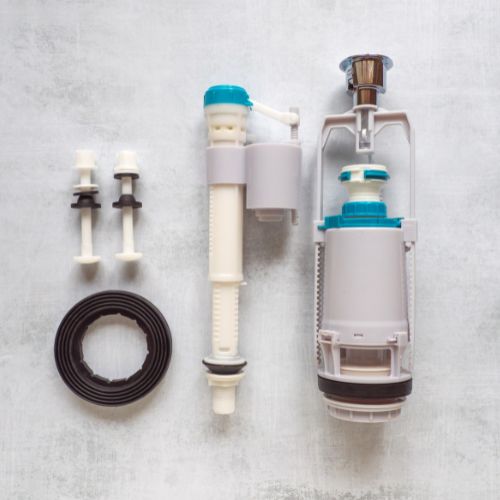
Worn-out parts and older models can impact the efficiency of your commode. We discussed the flapper above, but other parts that can wear out include the fill valve and flush valve.
The fill valve controls the water refill after the tank drains. A malfunctioning fill valve can cause the tank to overfill, leading to a higher water level in the bowl and slower drainage.
An aging or malfunctioning flush valve might not release enough water from the tank. This can cause the water to rise but not have enough force to clear the bowl effectively, resulting in slow drainage.
Old Toilets:
- Low-Flow Designs: Earlier versions of low-flow toilets, designed to conserve water, sometimes lacked the necessary force to clear the bowl efficiently. The reduced water volume could lead to a rise in water level and slow drainage, especially if there’s any obstruction in the trap.
- Narrow Traps: Older toilets might have narrower traps (the curved channel at the base of the toilet bowl). Over time, waste and other debris can accumulate here, causing water to rise and drain slowly.
- Inefficient Bowl Design: The design and shape of the bowl can impact the swirling motion of water during a flush. Older models may not have an optimized bowl design, leading to inefficient water movement and slow drainage.
Toilets need up to two gallons of water per flush, older models may require even more. If your toilet tank is not filling properly, the water level in your tank will be too low it won’t flush properly.
Collapsed Drain Lines
A collapsed drain line means a section of the underground piping has caved in or been seriously deformed. It is a serious plumbing issue that should be addressed as soon as possible.
When a line collapses, it restricts the flow of wastewater, causing:
- Inadequate Drainage: A partial collapse means that only a small amount of water can pass through the affected section of the pipe at a time. This can result in the toilet draining more slowly than usual.
- Complete Blockage: A full collapse or a severe deformity can completely block the flow. In such cases, the toilet might not drain at all, and there’s a risk of wastewater backup into the home.
- Gurgling Sounds: As water struggles to flow through the restricted pipe, it can create gurgling or bubbling noises.
- Multiple Fixtures Affected: Since the main line serves more than just the toilet, other fixtures like sinks, bathtubs, and showers might also exhibit drainage problems.
How to Fix a Slow Draining Toilet
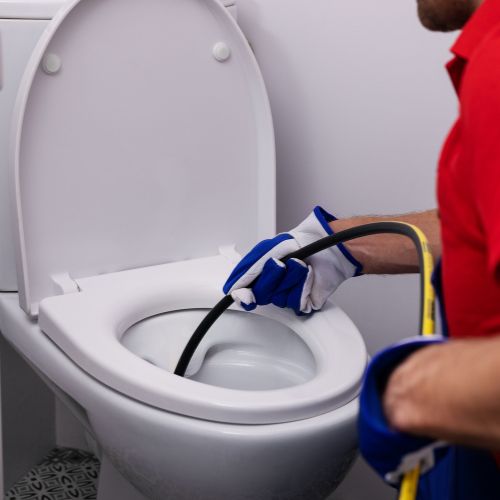
Now that you know why your loo is draining slowly, lets take a look at some DIY fixes and when you need to call a plumber.
Unclogging a Slow Draining Toilet
Common household items like condoms and cat litter can easily cause an obstruction. Here are some tips to unclog a slow draining toilet:
Use a Plunger
As an Amazon Associate, I earn from qualifying purchases.
It’s hard to imagine a home without a toilet plunger (#CommissionsEarned), which is why we put it on top of the list. The plunger has a cup shape, allowing you to seal it to the toilet bowl surface. Here’s what you should do:
Press the plunger firmly with both hands. After that, pump the tool down and up to create a strong vacuum pressure – keep pumping until the plunger stops moving.
The tool stops when the pressure is high, so you should pay attention to the sounds — when the clog breaks, it will flow away with gurgling. Now you can remove the plunger and flush the toilet to eliminate the waste remnants.
A Toilet Auger
The toilet auger (AKA drain snake #CommissionsEarned) is the drill that runs through the plumbing system to break clogs. It’s a metal tool with a corkscrew and sharp edges, which allows it to cut and pull sturdy waste. Use it like this:
- Insert the drill into the toilet bowl with the corkscrew facing downwards.
- Grab the auger handle and turn it clockwise to make pressure — it will help the snake go through the drainage pipes.
- If you apply enough force, the drill can hit and break the clog in the pipes.
- Pull out the snake slowly to extract all of the clog remnants.
- Flush your toilet to complete the waste removal process.
Dish Soap
Dish wash soap is a more elegant way to get rid of the clogs in your toilet. Here’s what to do:
- Pour half a cup of dish soap (#CommissionsEarned) into the toilet bowl.
- Pour a gallon of hot water into the bowl (don’t use boiling water).
- Let it all rest in the bowl for five minutes.
- Try flushing the toilet again and see if the water drains away any faster.
- If if didn’t fix this problem, repeat the process once more.
Porcelain, like many ceramic materials, can be sensitive to rapid temperature changes causing “thermal shock.” When boiling water comes into contact with the cooler surface of a porcelain bowl, the sudden and extreme temperature difference can cause the porcelain to expand rapidly.
The colder the toilet bowl, the higher the risk. For instance, in winter or in colder climates, the contrast between the boiling water and the cold porcelain can cause thermal shock. Old porcelain toilets that have been subjected to wear and tear over the years might be more vulnerable to thermal shock.
Vinegar and Baking Soda
White vinegar is a cheap cleaning weapon and an excellent mineral remover. It works well in combination with baking soda. Follow these steps:
Pour a cup of baking soda (#CommissionsEarned) and two cups of vinegar (#CommissionsEarned) into the bowl. Let it rest for 5-10 minutes minutes, then pour hot water down the drain. Flush the toilet and let the solution work for about half an hour.
Vinegar and baking soda should break the clogs by now, but you must flush the toilet once again to test its performance.
One thing we need to highlight is that all commercial cleaners aren’t the same. Some products like Drano or bleach don’t belong in the toilet – they can’t break clog, and can seriously harm the plumbing pipes.
Inspect and Clean Blocked Vents
Inspecting a vent requires climbing on the roof of your home, so it may be best to call a plumber for safety reasons.
If you want to give it a go, visually inspect the top of the vent pipe for obvious blockages like leaves or birds nests. If you can’t see a blockage, use your garden hose to pour water down the vent pipe. If it backs up, there is likely a blockage.
You can use an auger, feeding it down from the top of the vent to clear any debris.
Replace Worn Out Parts
Older toilets and worn-out parts might have served well in their prime, they can become less efficient over time.
Adjust the Chain: Ensure the chain has a little slack but not so much that it gets caught under the flapper.
Clean the Flapper: Remove any mineral deposits by cleaning the flapper with a mild cleaner.
Test the Seal: Turn off the water supply, flush to empty the tank, and then place a dye tablet or some food coloring in the tank. If color seeps into the bowl, the flapper isn’t sealing properly.
Replace Worn-Out Parts: Regularly inspect the toilet’s internal components. Replacing degraded parts like the flapper or valves can often resolve drainage issues.
Consider an Upgrade: If you have a much older model and frequently face drainage problems, it might be time to consider updating your toilet. Modern toilets are designed for better performance and water conservation.
Regular Maintenance: Clearing out any obstructions and cleaning the toilet’s internal components can help maintain optimal flushing and drainage.
Clearing rim jets and jet holes for better flushing
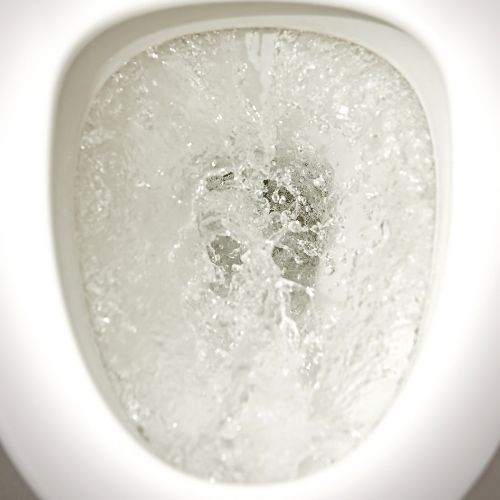
Toilet ports and rim jets must be clean and free of obstructions. The good thing is that you don’t need special tools for this job. It’s enough to use your favorite toilet cleaner, a wire coat hanger, and the toilet brush. Here are the steps:
- Stretch the coat hanger to get a piece of wire.
- Insert the wire and move it through the holes where the water flows. That should be enough to dislodge clogs in small drains such as toilet ports.
- Pour a cup of cleaning product into the bowl.
- Grab the brush and scrub the rim jet openings. Together with the cleaning product, the brush will remove stubborn stains and clog remnants.
- Flush the toilet a couple of times. It will help you eliminate the waste from the toilet bowl and check if the toilet works properly.
You can also try adding one tablespoon of dish soap to the overflow pipe (located inside the tank). Allow 10-15 minutes for the soap to go down the pipe, then flush. The soap will help clean the rim jets and holes from the inside out.
Increase the Water Level in the Tank
Toilets usually need up to two gallons of water per flush, but older models may require even more. If your toilet tank is not filling properly, the low water level will cause a toilet that doesn’t flush properly.
A weak pressure leaves the bowl struggling with debris, so you get a slow flush.
Remove the toilet tank lid. If too stiff, use a flathead screwdriver to detach the lid. After that, you can use one of these two tricks to raise the tank’s water level.
Remove Foreign Objects
Homeowners sometimes put an object in the cistern to clean it or to reduce water consumption. It is often the case with Fabuloso, but people also use other bottles and bricks to decrease water usage.
If you have a foreign object in the tank, take it out. As soon as you do this, the tank will fill full of water. It will release more water into the toilet bowl with each flush, increasing efficiency.
Adjust the Toilet Float
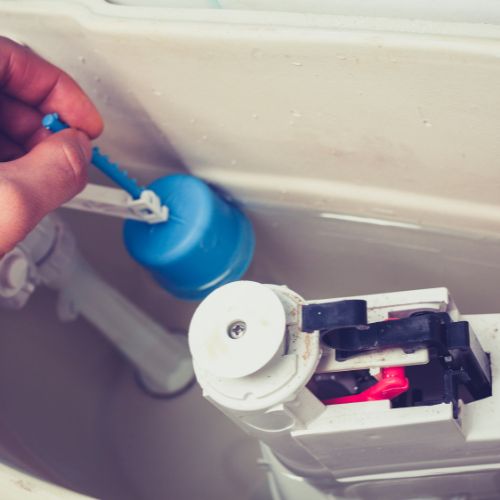
The second solution is more technical but also simple. The tank float is a plastic ball controlling the water level in the tank. If you want more water in the tank, you need to lift the float. Here’s how:
Turn off the toilet water supply by closing the shutoff valve behind the bowl — twist the valve clockwise. Then, flush the toilet to empty the tank. The next task is to grab the plastic float with your fingers and pull it up gently.
The float should stay an inch below the tank top. Now you can put back the tank lid and open the supply valve. Finally, you should test the toilet to see if the toilet water rises again — it should not do that after raising the float.
Other Issues Why Toilet Water Rises Then Slowly Drains
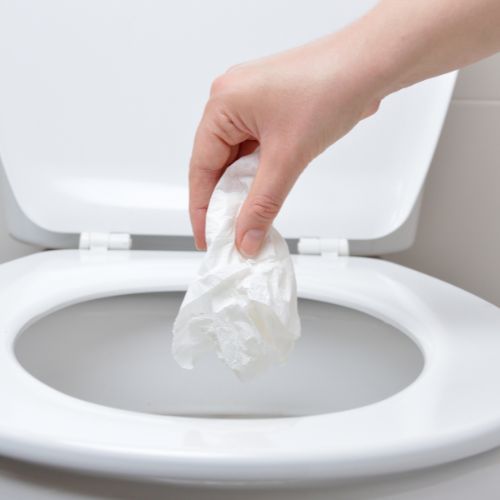
A slow draining toilet may not be the only bathroom issue you’re facing, so we want to mention a few other problems. Here are the most common setbacks:
A Slow Flushing Toilet
If your toilet is not flushing strong enough, it can reveal more than one problem. You may have a low-flow toilet that needs a stronger flushing mechanism.
Clogs are the second cause of weak flushes as they occur in the pipes, rim jets, and air vent. In each case, you’ll need to unclog the toilet with salt or some other tool or product.
The Leaking Loo
Your toilet can leak at its base, but you can also see puddles from leaking tank bolts, nuts, a cracked bowl, and other components. All of these issues require immediate repair because you don’t want to flood the toilet.
Frequently Asked Questions
How can I unblock my slow draining toilet?
You can unblock a slow draining toilet by using a plunger or auger. These plumbing tools help dislodge obstructions and drain buildup, and are the first step to fix a slow flushing toilet.
Will the slow draining toilet unclog itself?
A slow draining toilet probably won’t unclog itself. That’s because the clogs are often too hard to dissolve on their own, so you’ll need to use a tool to decompose them.
When to call a Plumber
If you’ve tried these DIY tips and you still find your toilet is draining slowly, it’s time to call a plumber. A plumber can use tools such as CCTV inspections to find obstructions, tree roots and larger problems that could be the reason for water slowly draining.
Did We Solve Your Slow Draining Toilet Problem?
If you’re experiencing a slow-flushing toilet, it’s essential to diagnose the root cause. Some issues can be fixed with DIY solutions, while others might require the expertise of a plumber. They can help you diagnose the reason for a slow draining toilet, lack of flushing power, and why your toilet flushes slow.
Most times it can easily be fixed without needing a new toilet.
